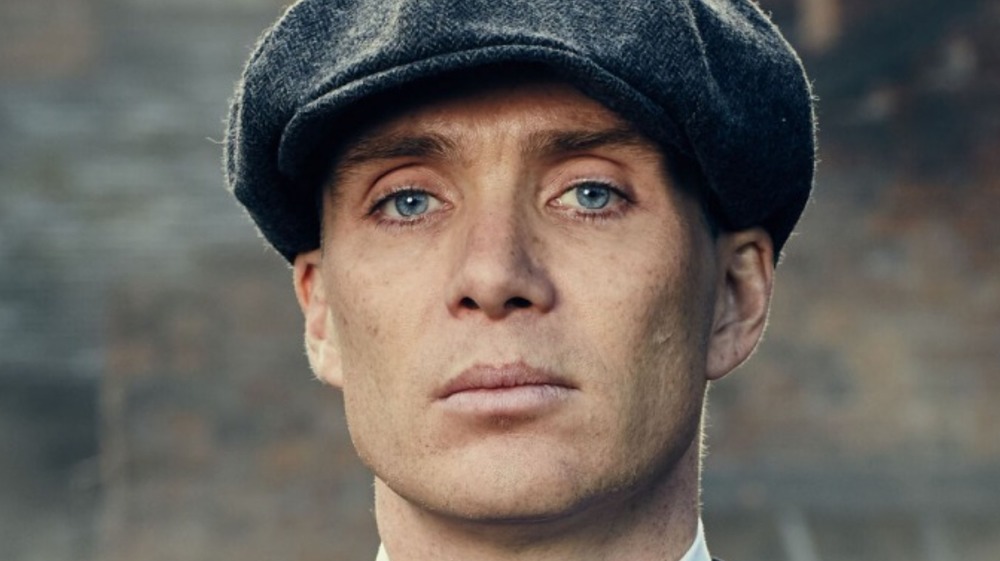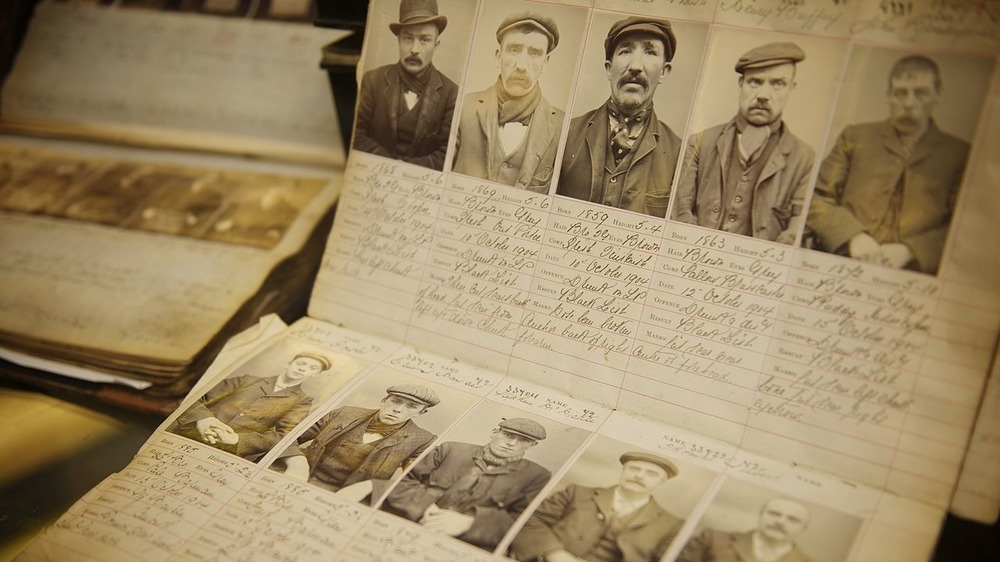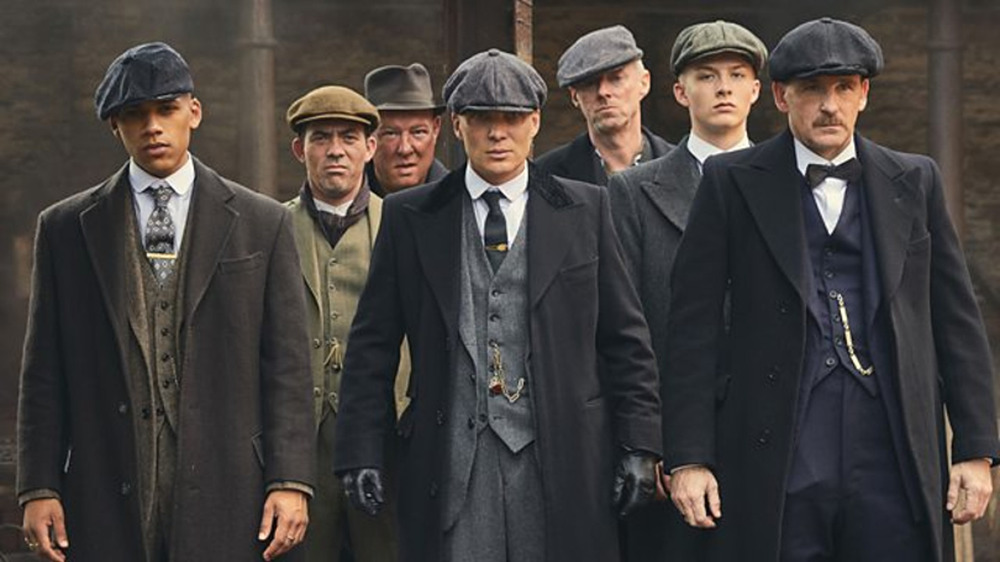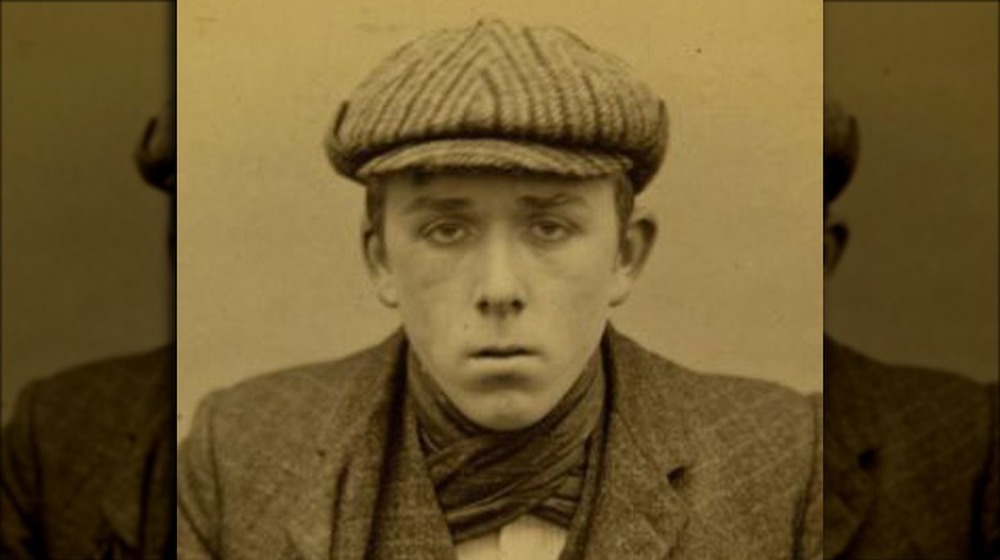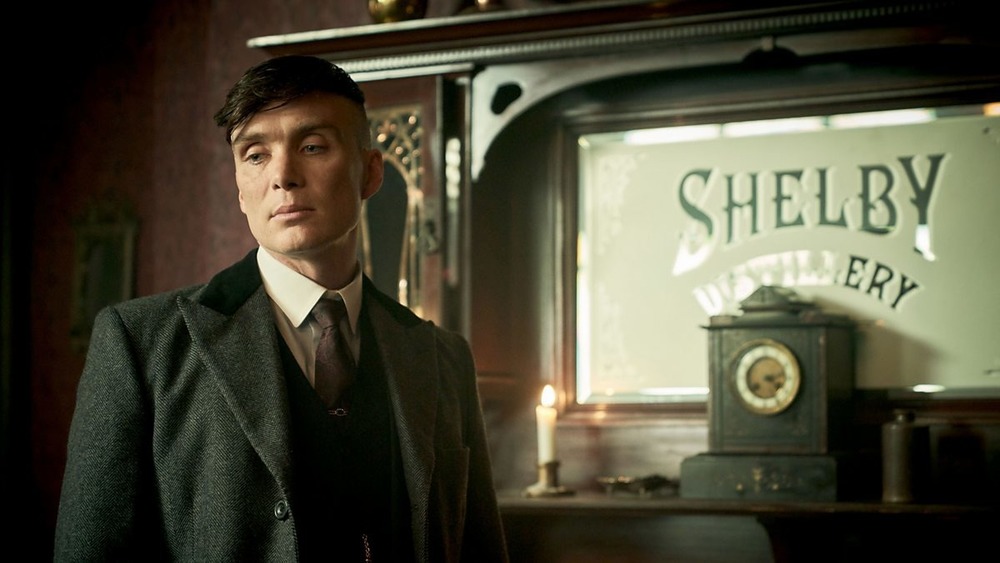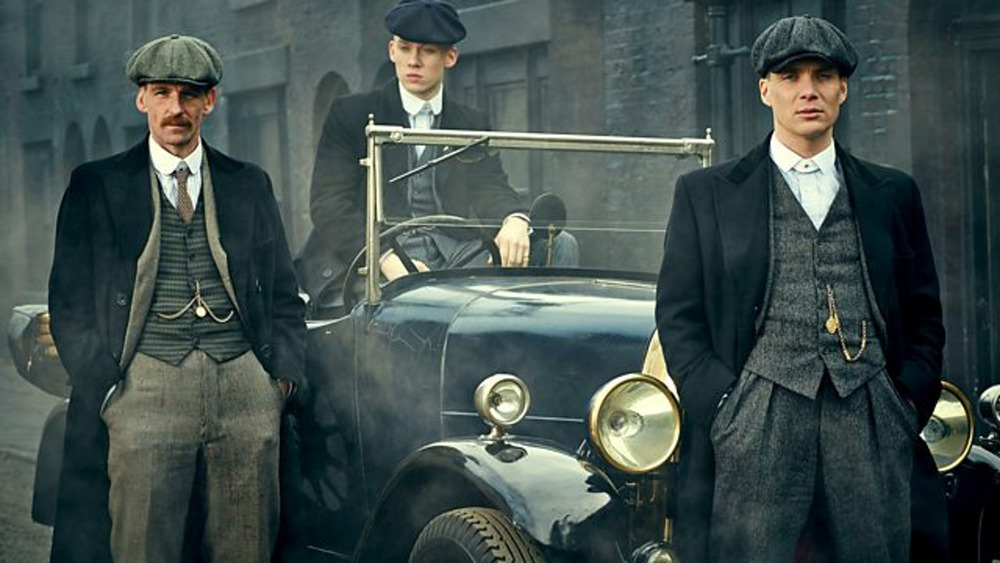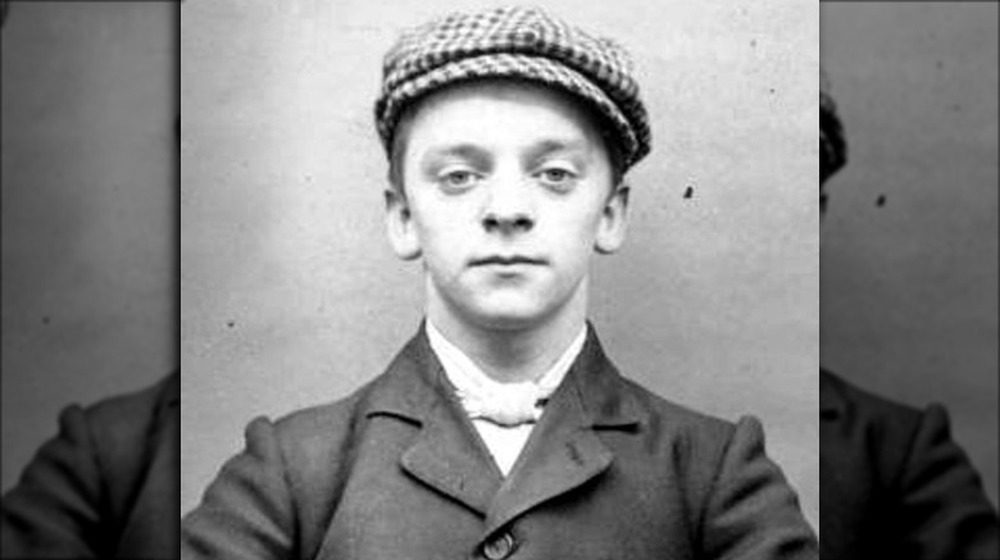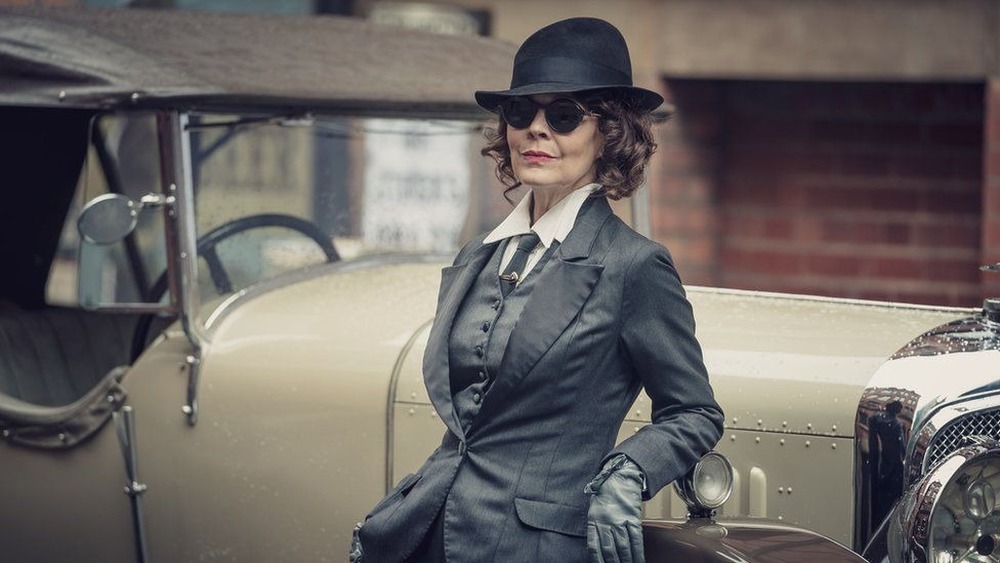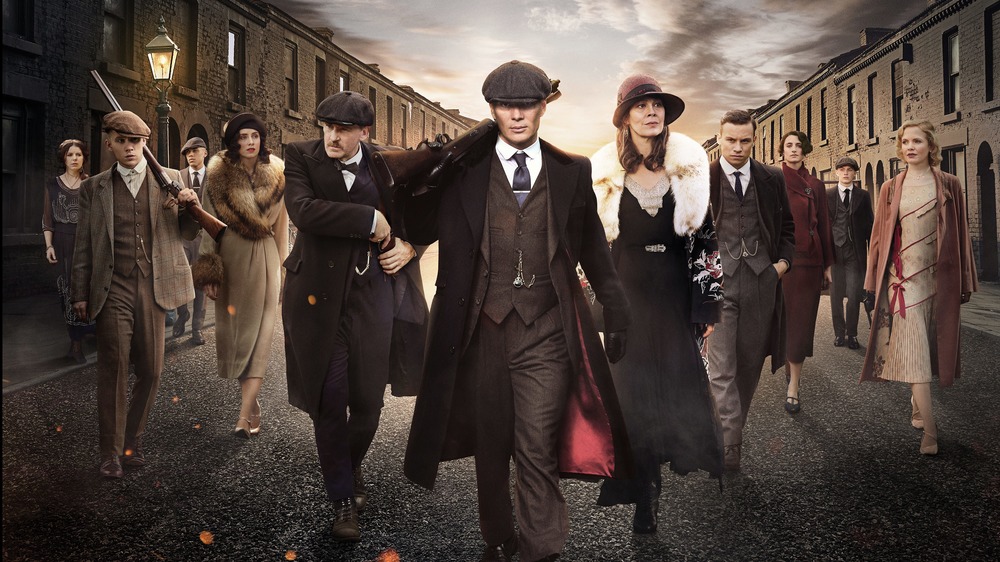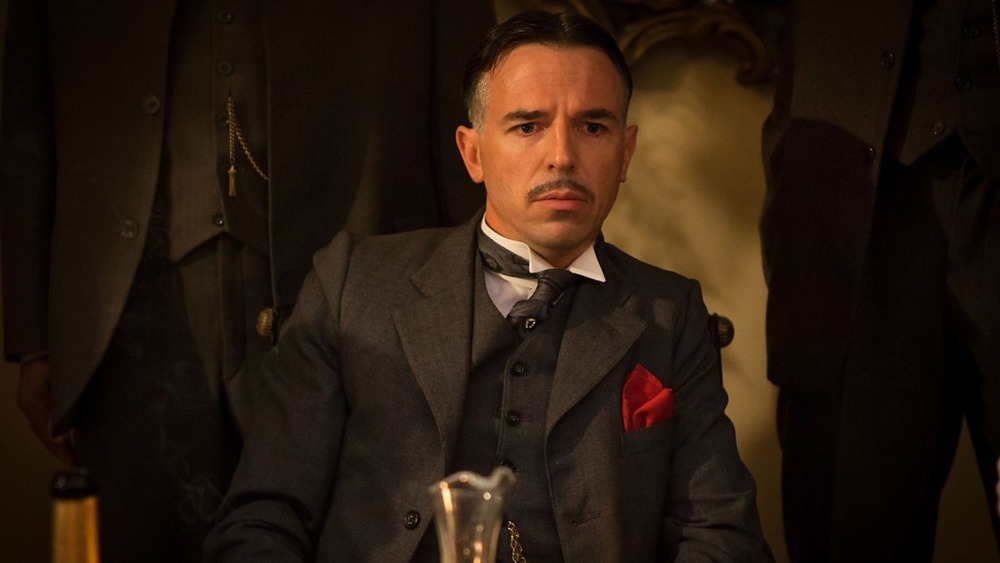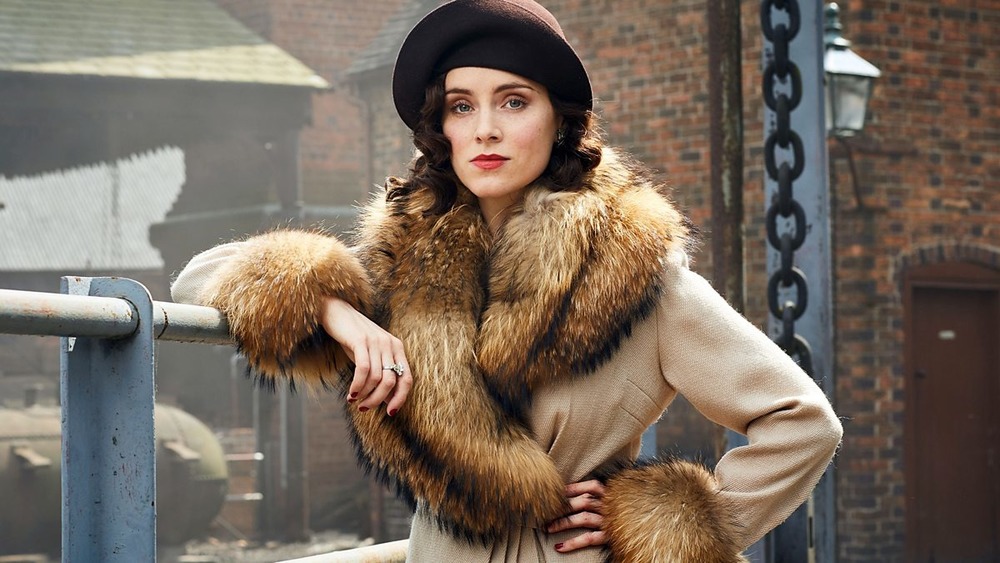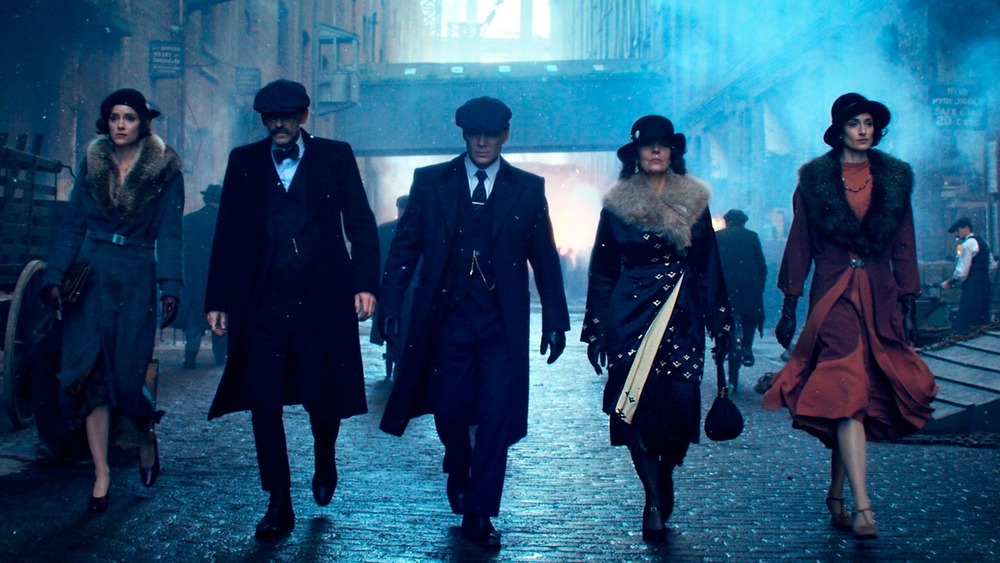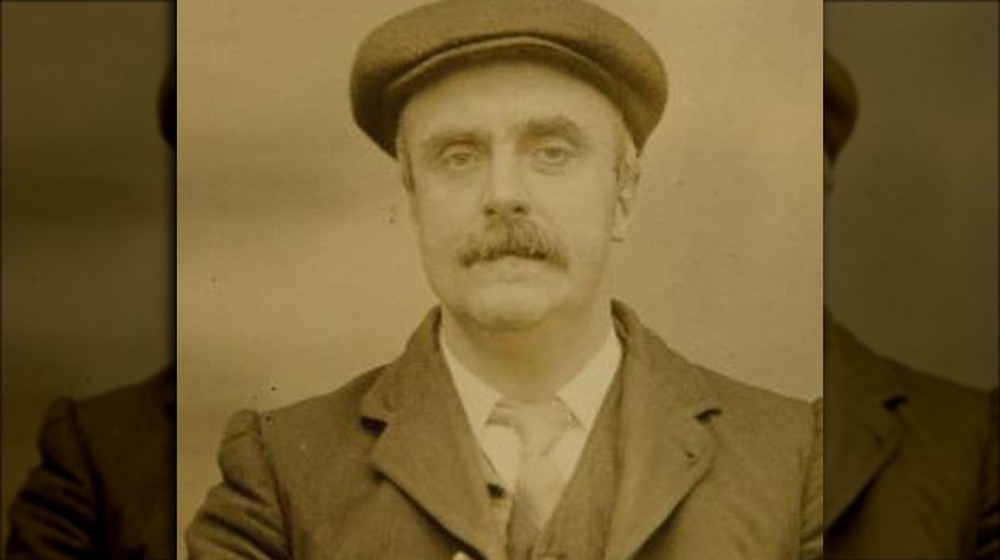The Truth About The Real-Life Peaky Blinders
It's hard to imagine a time in our lives when the phrase "by order of the Peaky Blinders!" wasn't part of our casual pop-culture conversation. Since 2013 Peaky Blinders – the stylish show about a well-dressed, violent criminal gang in 1920s and 1930s Birmingham — has given us gripping storytelling, fantastic old-school fashion, and regular doses of Cillian Murphy's cheekbones. Its final season will hopefully offer some closure on Tommy Shelby's quest for legitimacy and an end to the violent patterns of his life even as it leaves the audience wanting more.
Part of the appeal of Peaky Blinders is the brash style of the characters — their flair for overcoats, the way they can turn smoking a cigarette into a dramatic flourish. The show is so stylish, in fact, that it leads to questions about the historical accuracy behind it. While we're relatively certain criminals in early 20th-century Birmingham didn't spend nearly as much time walking in slow motion through smoky factories as is depicted in the show, it's definitely based on real criminal gangs in Birmingham — albeit loosely.
How loosely? Pretty loosely, actually. Here's the truth about the real-life Peaky Blinders.
There was a Peaky Blinders gang — but their hats weren't weapons
As BBC News tells us, Birmingham in the mid- and late 19th century was a violent, overcrowded place. Extreme poverty and a surplus of young men with no hope of employment led to the formation of street gangs, who would regularly brawl over control of tiny areas of the city. These gangs were brutally violent, and the brawls often left many of the gang members dead. Unlike organized crime organizations like the Mafia, however, these gangs didn't have a strict structure — they dissolved and formed into new groups on a regular basis. By the 1890s — 30 years earlier than in the series — a gang called the Peaky Blinders had formed.
As Esquire explains, the gang most probably didn't sew razors into their caps to blind people. Razor blades were considered an expensive luxury item in those days, and manufacture of them had only just begun, so it's unlikely the Blinders could have gotten their hands on them. As noted by Smithsonian Magazine, they most likely got their name from their peaked caps and the usage of "blinder" as a slang term for a stylishly dressed person. Gang members frequently used heavy belt buckles as cudgels in their street fights — or guns, when they could get them — but no razors.
The Peaky Blinders only reigned for about 20 years
The TV show Peaky Blinders begins its story in 1919, with the leader of the Blinders, Tommy Shelby, dealing with his undiagnosed PTSD from serving in World War I as he navigates the violent underworld of Birmingham. It also implies that the gang has been operating for a very long time in Birmingham — everyone treats the Blinders like an institution, after all, and local laws can be legislated simply by having an officer of the gang shout "by order of the Peaky Blinders!" which implies some serious social gravity.
But the real Peaky Blinders gang operated in Birmingham much earlier than the 1920s — and for a relatively short period of time. The Birmingham Mail reports that the Peaky Blinders emerged in the 1890s to challenge the Cheapside Sloggers, a prior gang that had ruled the streets for about two decades. The Blinders were supreme for about two decades themselves before being largely supplanted by rival gangs. By the time of the show's setting in the 1920s, a gang called the Brummagem Boys, which then mutated into the Birmingham Gang, reigned supreme in the area. But that name lacks the sizzle of the Peaky Blinders, which might explain why the producers tweaked the timeline.
"Peaky blinder" was a generic term
While there definitely was a criminal gang called the Peaky Blinders, it didn't last long. As BBC News notes, by the early 20th century, most of the criminal gangs in Birmingham vanished, and the Blinders themselves were gone by the 1910s. But their name lived on long enough for television to realize that it's one of the coolest gang names to have ever been invented — because they were so notorious in their time that they became the generic term for "violent criminals."
As author Philip Gooderson points out, the term "peaky blinder" came to be a common term for a specific kind of well-dressed, violent street thug. There are examples of police referring to members of other gangs as "one of their peaky blinders" and the like, which is a clear testimonial to the impact the Peaky Blinders gang had on the criminal underworld during their relatively brief existence. It's also possible that the term was occasionally used to refer to criminal gangs in general instead of a specific gang. Gooderson suggests that it was an early 20th century equivalent of something like the very British insult "chav," a brash, loutish, and violence-prone youth.
Some of the Peakys actually did serve in World War I
Having many of the members of the Peaky Blinders be traumatized veterans of World War I is a brilliant way to inject some sympathy for men who are otherwise horrible, horrible people. Let's face it: The Blinders kill and rob people, intimidate the weak, and do a remarkable amount of drugs. They're not good people, so letting them have a heroic side is a good writing decision. And war has a way of inspiring patriotism even among the worst elements of a society, so that scans as well.
But according to Smithsonian Magazine, it's also not totally inaccurate. We know for a fact that one major member of the real-life Blinders, Harry Fowler, actually did serve in World War I — and according to the Express & Star, he wasn't the only gang member to do so. Fowler's wartime experiences matched up with Tommy's horrifying memories — at one point, Fowler was buried alive when a mortar bombardment sent tons of earthworks crashing down on him. He emerged from the battle with serious injuries – Esquire reports that he couldn't speak or see for a long time after his return.
There were lots of gangs in Birmingham
In the Birmingham portrayed in the TV series, the Peaky Blinders have a few competitors, but it's nowhere near the number of competing gangs that actually existed. As reported by Crime and Investigation UK, the population of Birmingham had exploded by the mid-1800s, growing from about 74,000 to 630,000 in just a few decades. That overcrowding brought poverty and desperation, which led to the unemployed youth of the city forming violent street gangs. These gangs were usually centered on specific local areas, like one called the Garrison Lane Mob.
When the real Peaky Blinders came into being in the 1890s, the city had seen several major gangs rise and fall. As noted by author Philip Gooderson, many of these gangs were named with a variation of the term "slog," which referred to the street brawls that marked their battles for territory. A gang called the Cheapside Slogging Gang — or simply the Sloggers — had gained control over the city. They had ruled for two decades when the Blinders came up as their primary rival. The two gangs settled control over the streets in the usual way — by slogging it out, and the Blinders emerged victorious.
The Peaky Blinders were just violent thugs
On the TV series Peaky Blinders, Tommy Shelby (played by Cillian Murphy) is portrayed as a thoughtful criminal. He's not above killing or worse to get what he wants or to keep his family's interests safe, but he strives for a better, more peaceful life and lives according to a code.
In real life, the men in the Peaky Blinders were far from philosopher crooks capable of the sort of intricate plans Tommy comes up with. As Smithsonian Magazine reports, many of the real-life members of the gang were routinely arrested for small-scale, kind of dumb crimes. The crimes listed on their ancient rap sheets include impulse offenses like "shop-breaking" and "bike theft," which imply crimes committed as opportunity presented itself as opposed to carefully planned capers.
As BBC News notes, the gang as a whole was kind of dumb. Their main activity involved random attacks on just about anyone passing by — they simply targeted anyone who looked unlikely to defend themselves, and they would literally steal anything they could without any sort of plan or coordination. That lack of sophistication was one reason they were so feared — you simply never knew when they would strike, or against who. But it also means they weren't nearly as cool as their fictional counterparts.
The Peakys were incredibly stylish
One thing the TV series gets right about the real Peaky Blinders is their tendency to dress really stylishly. In fact, Smithsonian Magazine tells us they got part of their name from the 19th-century slang term "blinder," referring to a well-dressed, stylish person who dazzled you with their appearance.
Despite being a fairly unsophisticated and violent gang in a long line of unsophisticated and violent gangs, BBC News reports that the Blinders dressed to set themselves apart from the other gangs running wild on Birmingham's streets. They wanted to cultivate a classy image and ensure that people would know to be afraid when they approached. In fact, British GQ reports they were even better-dressed than the show depicts, wearing silk scarves, bell-bottom trousers — and, of course, their signature peaked caps.
The gambit worked. At the peak of their power in Birmingham, the Blinders became celebrities of a sort in the city. People often claimed to be members of the gang or associated with them simply to bask in the attention and the reflected glamour. In fact, when street brawls broke out, it was often impossible to know how many of the fighters were actually Peaky Blinders as opposed to locals hoping to be mistaken for them.
The Blinders hated the police
It might not be surprising to learn that a violent gang that attacked people in the street and regularly brawled for control of territory and criminal enterprises didn't get along with local law enforcement. Police certainly take on their work knowing full well that it will put them at odds with violent, brutal people who won't hesitate to hurt them. But where most gangs only target police when they feel threatened, the real Peaky Blinders took their hatred of the police to a whole new level.
According to I Love MCR, the Blinders routinely and specifically targeted the police for beatings and even murder. They called the practice "constable baiting," and over the course of the gang's two decades of dominance, it resulted in serious injuries for dozens of officers — and the deaths of several constables as well. Author Philip Gooderson notes that in 1897, the gang killed Constable George Snipe, and a few years later, they murdered an officer named Charles Philip Gunter. Several officers were forced to leave the police because of the injuries they received at the hands of the Peaky Blinders, simply for trying to do their jobs and keep the public peace.
Billy Kimber was a real Tommy Shelby
Tommy Shelby is presented as a tortured man who wouldn't mind "going legit" and leaving behind his family's criminal legacy — but he's tragically undermined every time he gets close to this goal. In the first season of the show, a rival gangster named Billy Kimber is his main antagonist. Kimber controls his own gang, as well as the racecourses outside Birmingham.
As Smithsonian Magazine reports, there really was a Billy Kimber, and he really was a dangerous gang leader. But the show plays around with the truth a bit. Billy Kimber led a gang called the Birmingham Boys, who defeated the Blinders in the early 20th century, becoming the dominant gang in the city in the 1920s.
According to I Love MCR, Kimber actually had been a Peaky Blinder, leaving that gang to form his own. Kimber was apparently very much like the character of Tommy Shelby — intelligent, violent, but charming when he wanted to be. The parallels are so striking that you have to wonder why the show's creators didn't just make him their main character — in fact, as reported by the Birmingham Mail, Kimber achieved Tommy's goal of going legit, dying after a prolonged illness in 1945 as a well-respected businessman.
The show's powerful women are based in fact
One interesting aspect of Peaky Blinders is how the female characters on the show are such powerful forces in what's normally considered to be a man's world: violent crime. Aunt Polly and the rest of the women involved with the gang are just as dangerous, intelligent, and formidable as the men, more so, even, since several of the Blinders are kind of dumb.
You might assume this is the writers bringing a modern-day viewpoint on gender equality to the time period, but it's actually not that crazy. As noted by I Love MCR, there is some evidence that the women of Birmingham may have officially or unofficially joined some of the local gangs, and as noted by British GQ, they definitely adopted some of the Peaky Blinder fashions in order to signal their connection to the gang, though that came with a price, as the gang members were very violent toward their women.
And as noted by Radio Times, the time period of the show is important. With most of the able-bodied men — even the criminals — off to fight during World War I, it fell to the women to hold things together. Many women ran businesses they normally wouldn't have been accepted at — including criminal enterprises like gambling rackets. So it's entirely possible that someone like Aunt Polly might have kept the Blinders' businesses going during the war — and then been reluctant to give it up when the boys came home.
Social changes, not rival gangs, killed off the Blinders
When you live a violent life, you should expect a violent end. On television, the Peaky Blinders seem destined to go out in a hail of gunfire, probably with something burning to the ground behind them, and the likelihood that any of the main characters survive the story seems small. In real life, it wasn't a rival gang that ended the reign of the Peaky Blinders and the other street gangs in Birmingham. It was economics.
As noted by British GQ, Birmingham began to grow and prosper in the 20th century, and families began moving out of the city center. I Love MCR reports that a combination of social changes began to transform the city and reduce the gangs' influence. These included smarter and more efficient policing, new factory jobs as the British economy transformed in the 20th century, and the rise of new ways for the young men to spend their time, including football clubs and the cinemas that sprang up. And as BBC News notes, as the city grew, the space between rival gangs grew, too, leaving them fewer reasons to fight. By the time World War II arrived, the gangs were mostly a memory without a shot needing to be fired.
Former Blinders were ashamed — and fell on hard times
Who doesn't want to fire a gun into the air and shout "by order of the Peaky Blinders!" while wearing some super-cool suit and overcoat? But the reality is that former members of the notorious street gang the Peaky Blinders were in no rush to have their violent pasts remembered — and many of them didn't retire lavishly on their ill-gotten gains.
As reported by BBC News, descendants of the members of the violent gang are usually amazed to discover the link because their ancestors didn't like talking about their criminal pasts. As noted by British GQ, historian Carl Chinn has found that they were usually ashamed of the violence they'd engaged in and did their best to bury their pasts.
And as Smithsonian Magazine reports, many of the Blinders had very sad ends even if they survived their connection with the gang. Harry Fowler returned from serving in World War I severely injured, for example, and supported himself in bizarre fashion by selling photographs of himself dressed in drag as a Red Cross nurse. It's a far cry from the huge estate and stables that Tommy Shelby has on the show.
